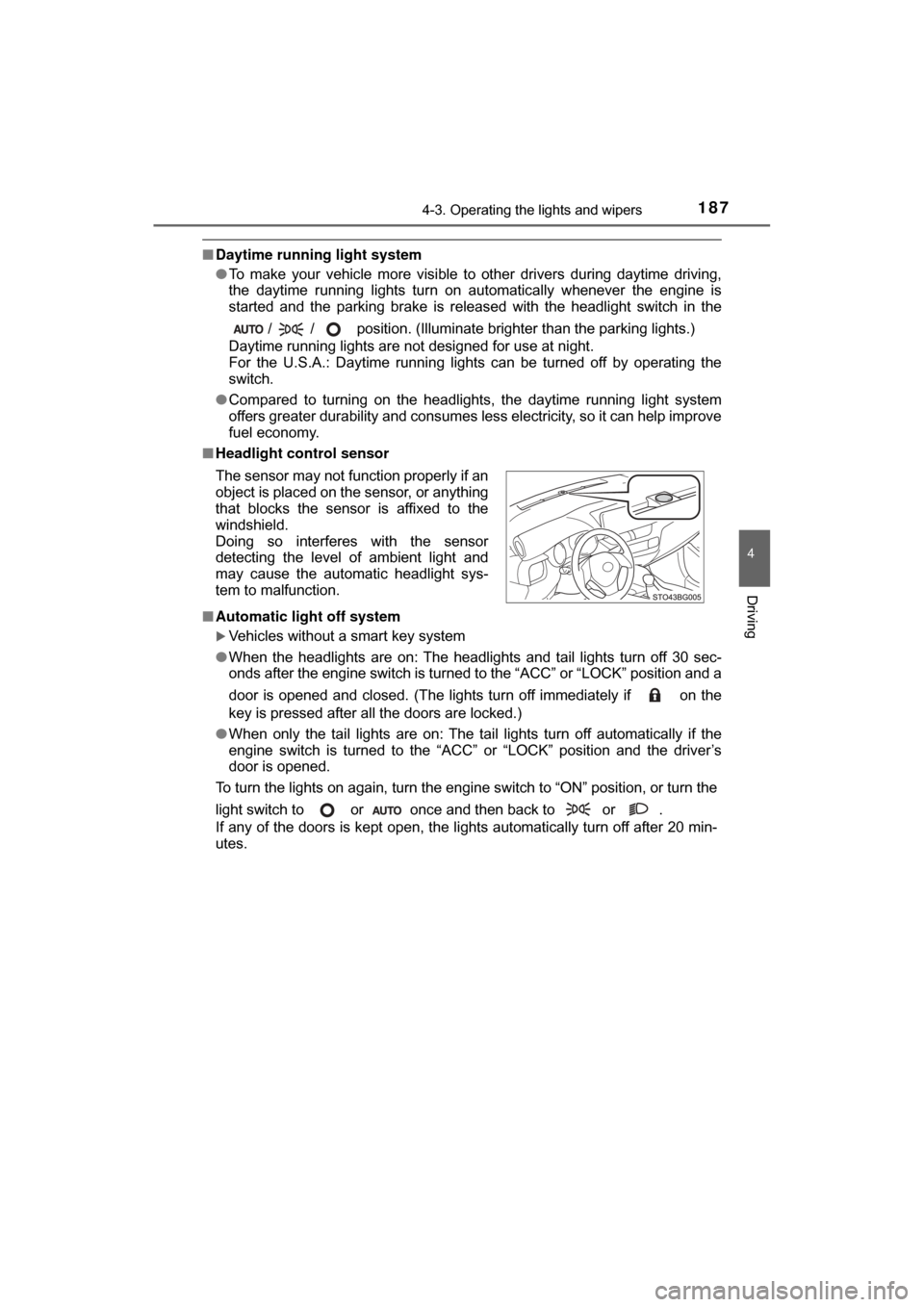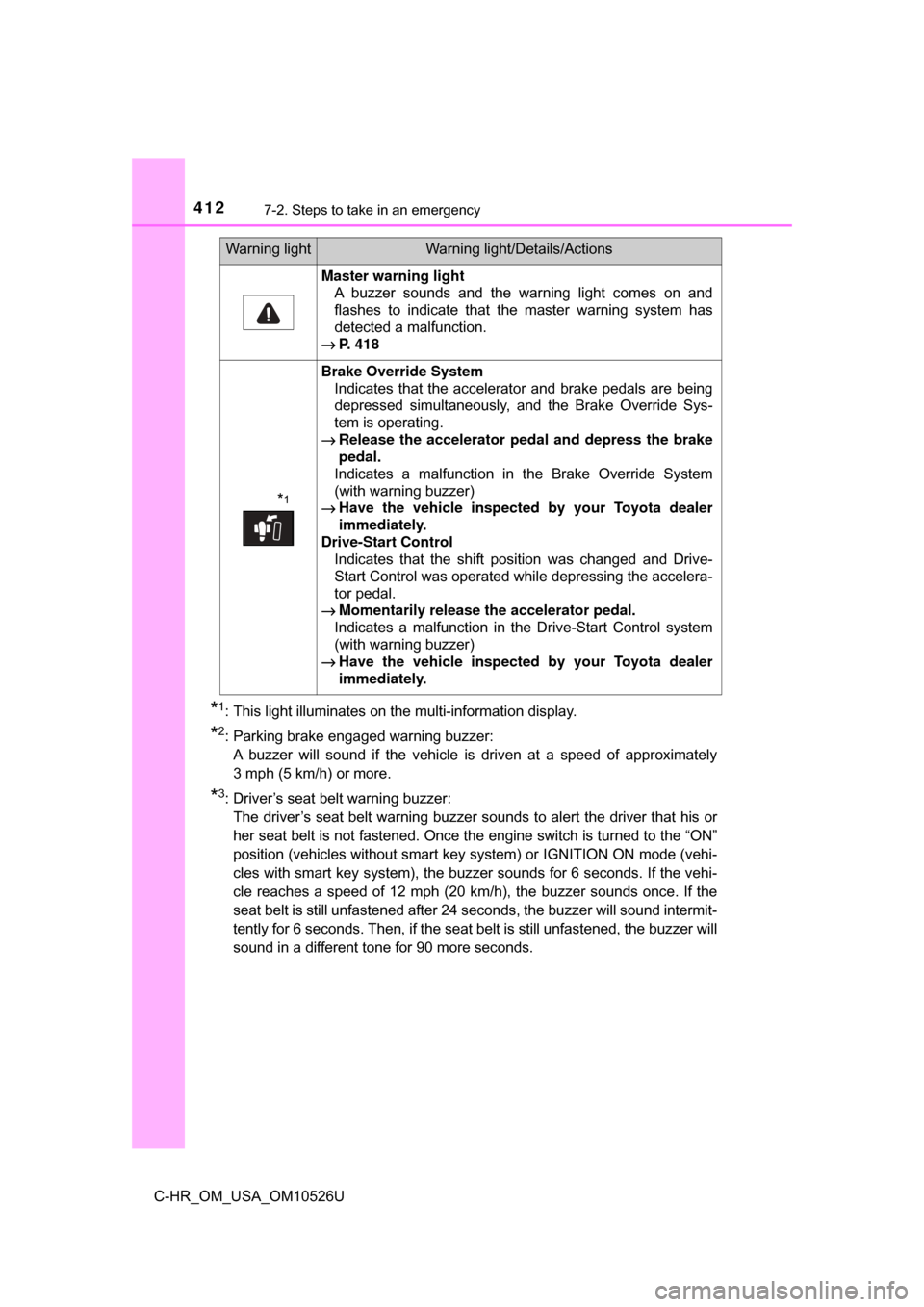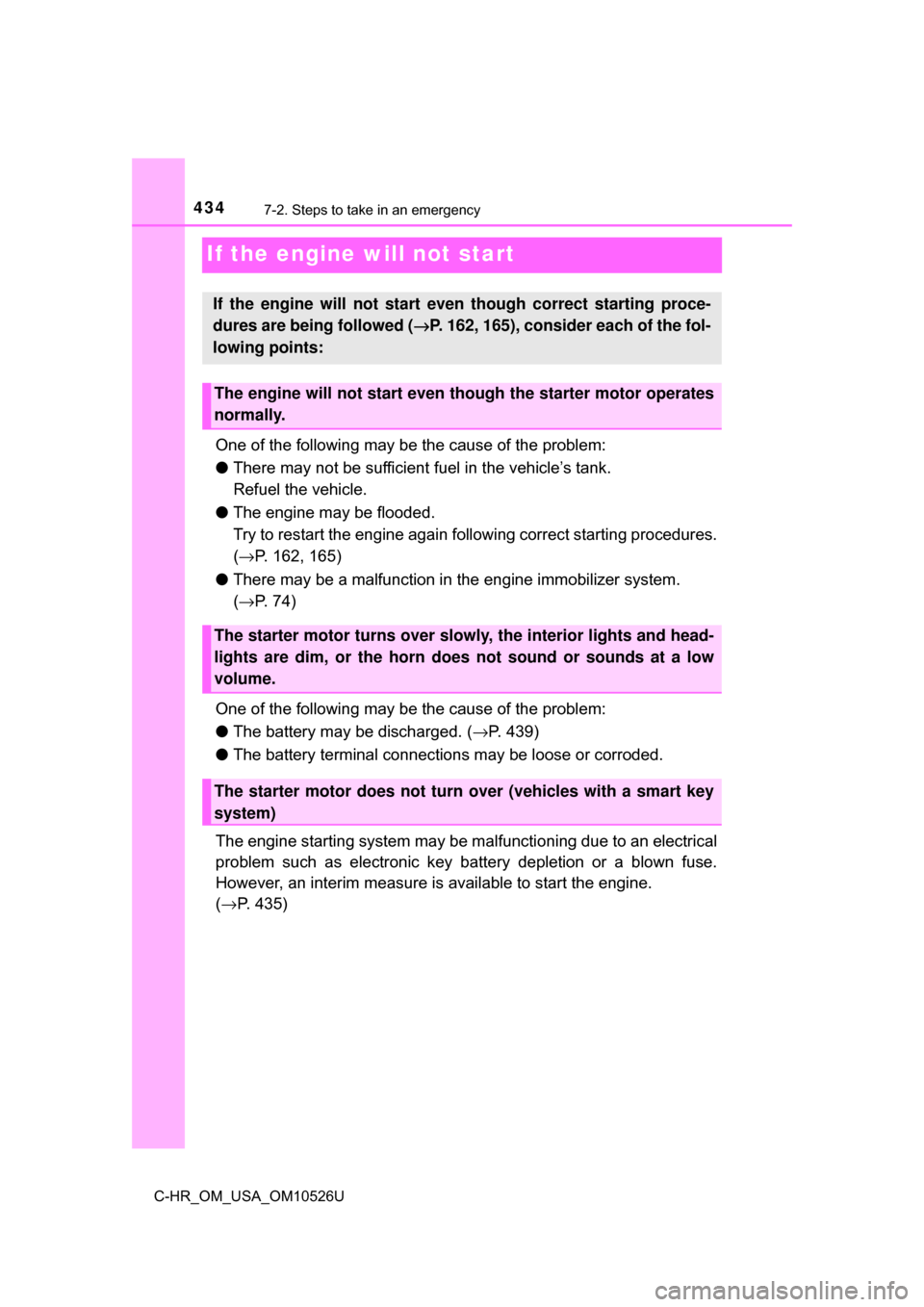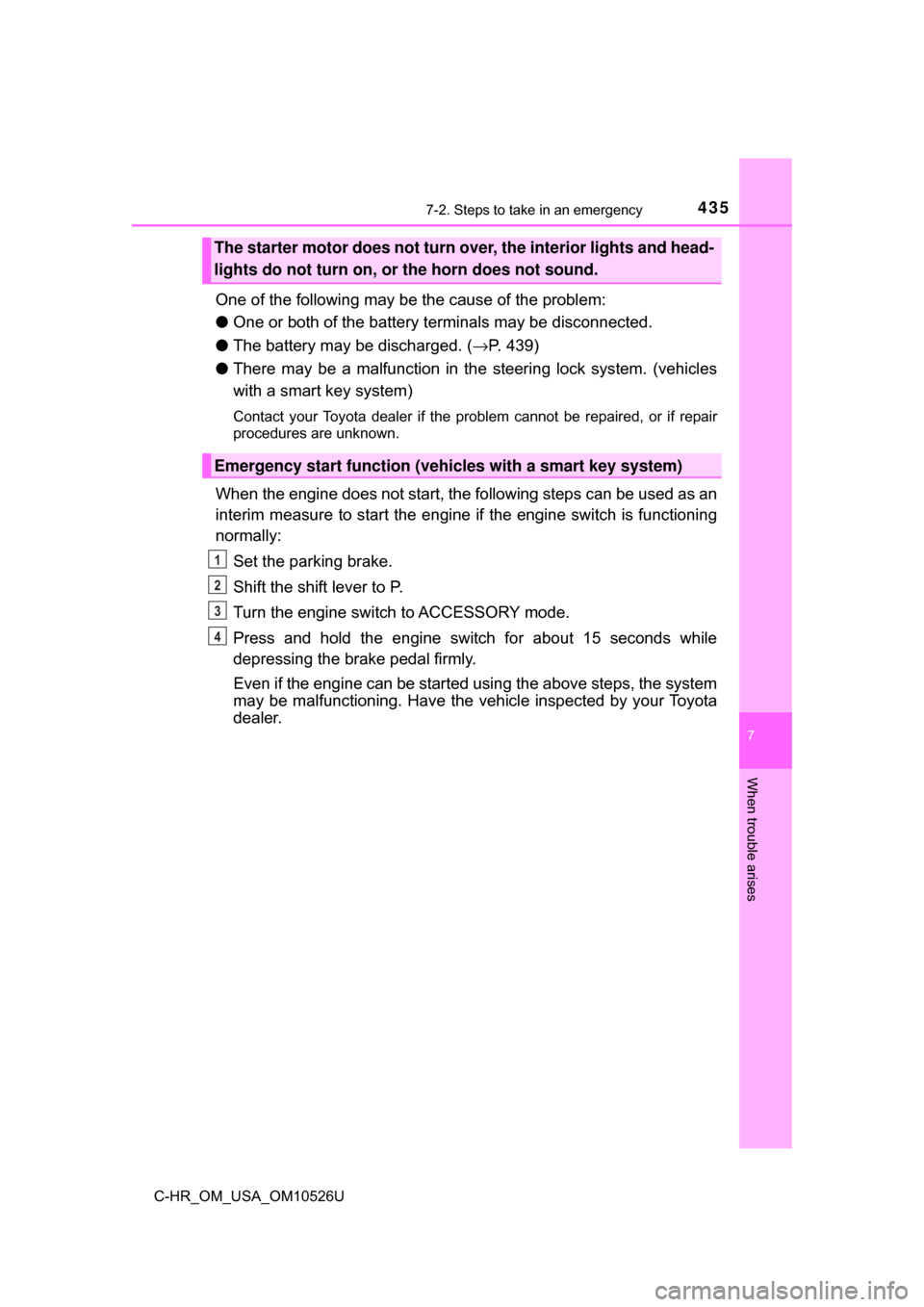system key malfunction TOYOTA C-HR 2018 1.G User Guide
[x] Cancel search | Manufacturer: TOYOTA, Model Year: 2018, Model line: C-HR, Model: TOYOTA C-HR 2018 1.GPages: 516, PDF Size: 9.32 MB
Page 179 of 516

1794-2. Driving procedures
4
Driving
C-HR_OM_USA_OM10526U
■Parking brake operation
●When the engine switch is not in the “ON” position (vehicles with\
out a smart
key system) or IGNITION ON mode (vehicles with a smart key system), the
parking brake cannot be released using the parking brake switch.
● When the engine switch is not in the “ON” position (vehicles with\
out a smart
key system) or IGNITION ON mode (vehicles with a smart key system),
automatic mode (automatic brake setti ng and releasing) is not available.
■ Automatic release function
The parking brake is automatically released when slowly depress the acceler-
ator pedal.
The parking brake will be released automatically under the following condi-
tions:
●The driver’s door is closed.
● The driver’s seatbelt is fastened.
● Shift the shift lever is in a forward or reverse position.
● The malfunction indicator lamp or brake system warning light is not illumi-
nated.
If the automatic release function does not operate, manually release the park-
ing brake.
■ If “EPB Frequently Operated, Wait a Minute.” is displayed on the
multi-information display
If the parking brake is operated repeatedly over a short period of time, the
system may restrict operation to prevent overheating. If this happens, refrain
from operating the parking brake. Normal operation will return after about 1
minute.
■ If “EPB Activation Incomplete.” or “E PB Unavailable” is displayed on the
multi-information display
Operate the parking brake switch. If the message does not disappear after
operating the switch several times, the system may be malfunctioning. Have
the vehicle inspected by your Toyota dealer immediately.
■ Parking brake operation sound
When the parking brake operates, a motor sound (whirring sound) may be
heard. This does not indicate a malfunction.
Page 180 of 516

1804-2. Driving procedures
C-HR_OM_USA_OM10526U■
Parking brake indicator li ght and parking brake lamp
● Depending on the engine switch position/mode, the parking brake indicator
light and parking brake lamp will turn on and stay on as described below:
Vehicles without a smart key system
In the “ON” position: Comes on until the parking brake is released.
Not in the “ON” position: Stays on for approximately 15 seconds.
Vehicles with a smart key system
IGNITION ON mode: Comes on until the parking brake is released.
Not in IGNITION ON mode: Stays on for approximately 15 seconds.
● When the engine switch is turned off with the parking brake set, the parking
brake indicator light and parking brake lamp stay on for about 15 seconds.
This does not indicate a malfunction.
■ Changing the mode
When changing the automatic mode on/off, the message will be shown on the
multi-information display and the buzzer sounds.
■ Parking the vehicle
→P. 147
■ Parking brake engaged warning buzzer
A buzzer will sound if the vehicle is driven with the parking brake engaged.
“EPB Applied.” is displayed on the multi-information display.
■ Warning messages and buzzers
Warning messages and buzzers are used to indicate a system malfunction or
to inform the driver of the need for caution. If a warning message is shown on
the multi-information display, read the message and follow the instructions.
■ If the brake system warning light comes on
→P. 410
■ Usage in winter time
→P. 286
Page 187 of 516

1874-3. Operating the lights and wipers
4
Driving
C-HR_OM_USA_OM10526U
■Daytime running light system
●To make your vehicle more visible to other drivers during daytime driving,
the daytime running lights turn on automatically whenever the engine is
started and the parking brake is released with the headlight switch in the
/ / position. (Illuminate brighter than the parking lights.)
Daytime running lights are not designed for use at night.
For the U.S.A.: Daytime running lights can be turned off by operating the
switch.
● Compared to turning on the headlights, the daytime running light system
offers greater durability and consumes less electricity, so it can help improve
fuel economy.
■ Headlight control sensor
■ Automatic light off system
Vehicles without a smart key system
● When the headlights are on: The headlights and tail lights turn off 30 sec-
onds after the engine switch is turned to the “ACC” or “LOCK” position and a
door is opened and closed. (The lights turn off immediately if on the
key is pressed after all the doors are locked.)
● When only the tail lights are on: The tail lights turn off automatically if the
engine switch is turned to the “ACC” or “LOCK” position and the driver’s
door is opened.
To turn the lights on again, turn the engine switch to “ON” position, or turn the
light switch to or once and then back to or .
If any of the doors is kept open, the lights automatically turn off after 20 min-
utes. The sensor may not function properly if an
object is placed on the sensor, or anything
that blocks the sensor is affixed to the
windshield.
Doing so interferes with the sensor
detecting the level of ambient light and
may cause the automatic headlight sys-
tem to malfunction.
Page 282 of 516

2824-5. Using the driving support systems
C-HR_OM_USA_OM10526U■
EPS operation sound
When the steering wheel is operated, a motor sound (whirring sound) may be
heard. This does not indicate a malfunction.
■ Automatic reactivation of TRAC and VSC systems
After turning the TRAC and VSC systems off, the systems will be automati-
cally re-enabled in the following situations:
● Vehicles without a smart key system: When the engine switch is turned to
the “LOCK” position
Vehicles with a smart key system: When the engine switch is turned off
● If only the TRAC system is turned off, the TRAC will turn on when vehicle
speed increases
If both the TRAC and VSC systems are turned off, automatic re-enabling will
not occur when vehicle speed increases.
■ Reduced effectiveness of the EPS system
The effectiveness of the EPS system is reduced to prevent the system from
overheating when there is frequent steering input over an extended period of
time. The steering wheel may feel heavy as a result. Should this occur, refrain
from excessive steering input or stop the vehicle and turn the engine of\
f. The
EPS system should return to normal within 10 minutes.
■ Operating conditions of hill-start assist control
When the following four conditions are met, the hill-start assist control will
operate:
● The shift lever is in a position other than P or N (when starting off forward/
backward on an upward incline).
● The vehicle is stopped.
● The accelerator pedal is not depressed.
● The parking brake is not engaged.
■ Automatic system cancelation of hill-start assist control
The hill-start assist control will turn off in any of the following situations:
● The shift lever is shifted to P or N.
● The accelerator pedal is depressed.
● The parking brake is engaged.
● 2 seconds at maximum elapsed after the brake pedal is released.
Page 412 of 516

4127-2. Steps to take in an emergency
C-HR_OM_USA_OM10526U
*1: This light illuminates on the multi-information display.
*2: Parking brake engaged warning buzzer:A buzzer will sound if the vehicle is driven at a speed of approximately
3 mph (5 km/h) or more.
*3: Driver’s seat belt warning buzzer: The driver’s seat belt warning buzzer sounds to alert the driver that his or
her seat belt is not fastened. Once the engine switch is turned to the “ON”
position (vehicles without smart key system) or IGNITION ON mode (vehi-
cles with smart key system), the buzzer sounds for 6 seconds. If the vehi-
cle reaches a speed of 12 mph (20 km/h), the buzzer sounds once. If the
seat belt is still unfastened after 24 seconds, the buzzer will sound intermit-
tently for 6 seconds. Then, if the seat belt is still unfastened, the buzzer will
sound in a different tone for 90 more seconds.
Master warning light A buzzer sounds and the warning light comes on and
flashes to indicate that the master warning system has
detected a malfunction.
→ P. 418
*1
Brake Override System
Indicates that the accelerator and brake pedals are being
depressed simultaneously, and the Brake Override Sys-
tem is operating.
→ Release the accelerator pedal and depress the brake
pedal.
Indicates a malfunction in the Brake Override System
(with warning buzzer)
→ Have the vehicle inspected by your Toyota dealer
immediately.
Drive-Start Control Indicates that the shift position was changed and Drive-
Start Control was operated while depressing the accelera-
tor pedal.
→ Momentarily release the accelerator pedal.
Indicates a malfunction in the Drive-Start Control system
(with warning buzzer)
→ Have the vehicle inspected by your Toyota dealer
immediately.
Warning lightWarning light/Details/Actions
Page 421 of 516

4217-2. Steps to take in an emergency
7
When trouble arises
C-HR_OM_USA_OM10526U■
If “See Owner’s Manual” is shown
●If “Braking Power Low Stop in a Safe Place See Owner’s Manual” is shown,
this may be a malfunction. Immediately stop the vehicle in a safe place and
contact your Toyota dealer. Continuing to drive the vehicle may be danger-
ous.
● Vehicles with a smart key system:
If “Entry & Start System Malfunction See Owner’s Manual” is shown, there
may be a malfunction. Immediately have the vehicle inspected by your
Toyota dealer.
■ If “Charging System Malfunction” is shown
Indicates a malfunction in the vehicle’s charging system. Immediately stop
the vehicle in a safe place and contact your Toyota dealer. Continuing to drive
the vehicle may be dangerous.
■ If “Engine Coolant Temperature high” is shown
Indicates that the engine coolant temperature is too high. Immediately stop
the vehicle in a safe place. ( →P. 443)
■ If “Engine Oil Pressure Low” is shown
Indicates that the engine oil pressure is too low. Immediately stop the vehicle
in a safe place and contact your Toyota dealer.
■ If “Maintenance Required Soon” is shown (U.S.A. only)
Indicates that all maintenance according to the driven distance on the mainte-
nance schedule
* should be performed soon.
Comes on approximately 4500 miles (7200 km) after the message has been
reset.
If necessary, perform maintenance. Please reset the message after the main-
tenance is performed. ( →P. 328)
*: Refer to the separate “Scheduled Maintenance Guide” or “Owner’s Manual
Supplement” for the maintenance interval applicable to your vehicle.
■ If “Maintenance Required Visit Your Dealer.” is shown (U.S.A. only)
Indicates that all maintenance is required to correspond to the driven distance
on the maintenance schedule
*.
Comes on approximately 5000 miles (8000 km) after the message has been
reset. (The indicator will not work properly unless the message has been
reset.)
Perform the necessary maintenance. Please reset the message after the
maintenance is performed. ( →P. 328)
*: Refer to the separate “Scheduled Maintenance Guide” or “Owner’s Manual
Supplement” for the maintenance interval applicable to your vehicle.
Page 434 of 516

4347-2. Steps to take in an emergency
C-HR_OM_USA_OM10526U
If the engine will not start
One of the following may be the cause of the problem:
●There may not be sufficient fuel in the vehicle’s tank.
Refuel the vehicle.
● The engine may be flooded.
Try to restart the engine again following correct starting procedures.
(→ P. 162, 165)
● There may be a malfunction in the engine immobilizer system.
(→ P. 74)
One of the following may be the cause of the problem:
● The battery may be discharged. ( →P. 439)
● The battery terminal connections may be loose or corroded.
The engine starting system may be malfunctioning due to an electrical
problem such as electronic key battery depletion or a blown fuse.
However, an interim measure is available to start the engine.
( → P. 435)
If the engine will not start eve n though correct starting proce-
dures are being followed ( →P. 162, 165), consider each of the fol-
lowing points:
The engine will not start even though the starter motor operates
normally.
The starter motor turns over slowly, the interior lights and head-
lights are dim, or the horn does not sound or sounds at a low
volume.
The starter motor does not turn over (vehicles with a smart key
system)
Page 435 of 516

4357-2. Steps to take in an emergency
7
When trouble arises
C-HR_OM_USA_OM10526U
One of the following may be the cause of the problem:
●One or both of the battery terminals may be disconnected.
● The battery may be discharged. ( →P. 439)
● There may be a malfunction in th e steering lock system. (vehicles
with a smart key system)
Contact your Toyota dealer if the problem cannot be repaired, or if repair
procedures are unknown.
When the engine does not start, the following steps can be used as an
interim measure to start the engine if the engine switch is functioning
normally:
Set the parking brake.
Shift the shift lever to P.
Turn the engine switch to ACCESSORY mode.
Press and hold the engine switch for about 15 seconds while
depressing the brake pedal firmly.
Even if the engine can be started using the above steps, the system
may be malfunctioning. Have the ve hicle inspected by your Toyota
dealer.
The starter motor does not turn over, the interior lights and head-
lights do not turn on, or the horn does not sound.
Emergency start function (vehicles with a smart key system)
1
2
3
4
Page 513 of 516

513Alphabetical index
C-HR_OM_USA_OM10526U
Vanity lights ............................. 313Wattage ................................ 457
Vanity mirrors .......................... 313
Vehicle data recording ................ 7
Vehicle identification number ................................... 450
Vehicle Stability Control (VSC) ...................................... 279
VSC (Vehicle Stabilit y Control) .... 279
Warning buzzers Blind Spot Monitor (BSM) ..... 253
Brake system ....... ................. 408
Downshifting ......................... 173
Electric power steering ......... 409
Engine coolant temperature ........................ 411
Engine oil pressure ............... 408
Engine system ....... ............... 409
LDA (Lane Departure Alert) ................................... 226
Key reminder ........................ 163
Open back door .................... 113
Open door ..................... 110, 113
Pre-collision warning............. 212
Radar cruise control.............. 245
Parking brake........................ 180
Seat belt reminder ................ 411 Warning lights ........................... 79
ABS ...................................... 409
Brake Override System ........ 412
Brake system ................ 408, 410
Charging system................... 408
Electric parking brake ........... 410
Electric power steering system .......... ...................... 409
Engine oil pressure ............... 408
High engine coolant temperature warning
light..................................... 411
Low fuel level ........................ 411
Malfunction indicator lamp .... 409
Master warning light ............. 412
PCS warning light ................. 410
Seat belt reminder light......... 411
Slip indicator ......................... 409
SRS ...................................... 409
Tire pressure ........................ 411
V
W